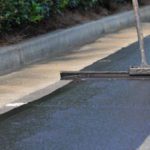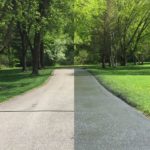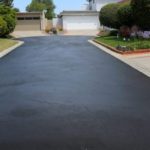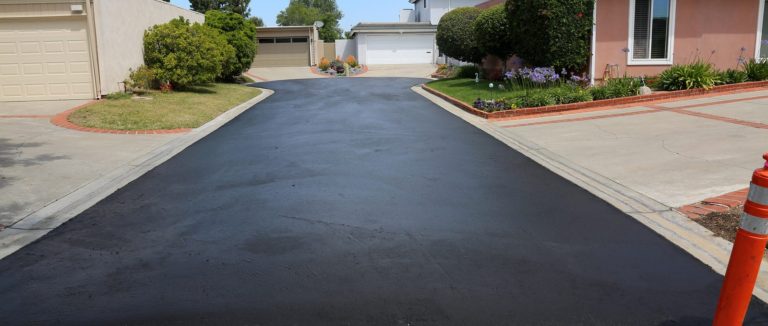Pitting, flaking, and staining are undesirable qualities on an asphalt surface. Tuning in to the weather forecast before seal coating will help you avoid some of these problems. This is attributable to the fact that weather conditions can significantly impact the effectiveness and longevity of the sealer.
Benefits of seal coating
There are several compelling reasons why you should engage a competent asphalt contractor to seal coat your asphalt surface, including the following:
- It extends the life of your asphalt pavement.
- It helps you avoid expensive repairs down the line.
- It protects your pavement from water damage.
- It protects your pavement from the sun.
- It protects your pavement against automotive fluids.
- It makes your pavement look more appealing.
What is the ideal temperature for sealing an asphalt pavement?
The ideal conditions for seal coating application are during the daytime when the ground and air temperatures are at least 50°F, and no rain is in the forecast for at least the next 24 hours. It is worth noting that seal coating will not produce the desired results if these recommendations are not followed.
How does seal coating in cold temperatures affect the final application?
 Seal coating at temperatures below the manufacturer’s recommended range can result in problems such as tire scuffing, power steering marks, discoloration, and reduced durability.
Seal coating at temperatures below the manufacturer’s recommended range can result in problems such as tire scuffing, power steering marks, discoloration, and reduced durability.
It can get tricky for the sealer to adhere to the asphalt surface when pavement temperatures dip below 50°F. Furthermore, when the sealer is applied at lower temperatures, the binder in the sealer has a harder time fusing and sticking together to produce an effective film.
Reduced adhesion and film formation will result in a sealer that is less resistant to peeling.
What happens to sealers when they are applied at temperatures below 50°F?
Seal coating products are water-based emulsions. While the drying and curing process is in progress, the water evaporates, and the solid ingredients mix to form a film that adheres to the surface. As water leaves the system, the solid ingredients come closer together until they coalesce — or, in other words, they flow into each other to form a bond (particularly the binder).
 The binder is the glue that holds the film together (or “cohesion”) and makes the sealer adhere to the pavement (or “adhesion”). In response to the drop in temperature, the binder becomes harder, making it more difficult to cohere and adhere to the pavement.
The binder is the glue that holds the film together (or “cohesion”) and makes the sealer adhere to the pavement (or “adhesion”). In response to the drop in temperature, the binder becomes harder, making it more difficult to cohere and adhere to the pavement.
You may also notice discoloration, increased tire scuffing, power steering marks, and decreased durability. However, the film may crack and flake off entirely in severe cases.
What is the effect of cooler temperatures on drying?
When the temperature drops, the evaporation rate of water slows down as well. The drying rate of the sealer at 50 ℉ is considerably slower than it is at 80 ℉. In some cases, it could take twice as long for the sealer to dry at 50 ℉ as it does at 80 ℉. High humidity levels, overcast weather, and a dew point within 5° of the temperature are all examples of  weather-related variables that can slow the drying process. When an asphalt sealer retains water, it will stay soft and more susceptible to flaking, peeling, tire scuffing, and power steering marks.
weather-related variables that can slow the drying process. When an asphalt sealer retains water, it will stay soft and more susceptible to flaking, peeling, tire scuffing, and power steering marks.
Instead of applying more coats of sealer during the colder months, use this time only to wear them. Warmer temperatures will be upon us before you know it. Spring has already arrived, and summer will be here before we know it — bringing the seal coating season along!
Conclusion
Sealcoating your asphalt pavement is an important step that should not be overlooked. While delaying seal coating could save you money in the short term, it will undoubtedly cost you more money in the long run when your asphalt pavement cracks and deteriorates. To learn more about seal coating or receive a quote for high-quality pavement sealing, get in touch with a local asphalt contractor.
Address
Commonwealth Paving, 136 Outerloop, Louisville, Kentucky 40214
Phone: 502-459-7283, Fax: 502-456-2678
Opening Hours
| Monday | 9:00 AM – 5:00 PM |
| Tuesday | 9:00 AM – 5:00 PM |
| Wednesday | 9:00 AM – 5:00 PM |
| Thursday | 9:00 AM – 5:00 PM |
| Friday | 9:00 AM – 5:00 PM |
| Saturday | Closed |
| Sunday | Closed |







